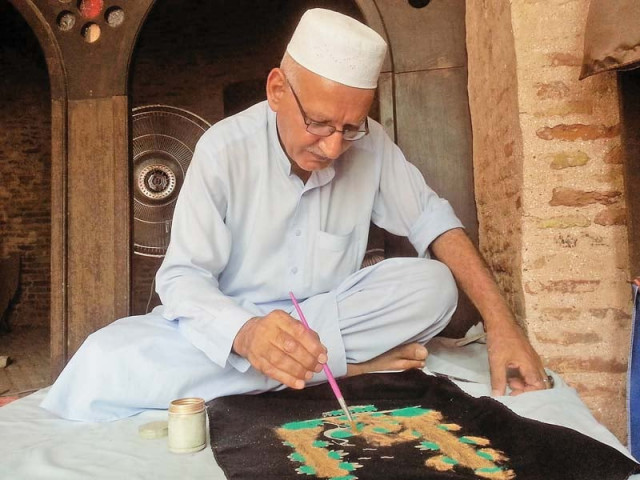Keeping it alive: Artist shares century-old technique, secrets of wax painting with 10 students
Maestro who was awarded Tamgha-e-Imtiaz by govt is recognised internationally
Riaz Ahmad at work. PHOTOS: EXPRESS
PESHAWAR:
While painting birds with wax on a piece of cloth with intense focus and dedication, 65-year old Riaz Ahmad smiles at an onlooker. The rust, red, gold, silver, green and blue shine brightly against the black cloth and the maestro’s pride is hard to miss. His eyes that sparkle brighter than the colours with which he paints, immediately reveal a great sense of ownership and diligence in work.
Ahmad has kept the dying art of wax painting alive in the province. He has not only maintained the task for over several generations but has been benevolent enough to share his techniques and secrets with people beyond his family.
Ahmad has won several awards and is internationally recognised for his art. However, what makes him immensely proud are not certificates and trophies but the fact that he has empowered 10 women in the city by teaching them the rare art of which he was the sole keeper in the past.
Making it immortal
The skill of wax painting had been in Ahmad’s family for centuries. He taught the work to his only son Fayaz Ahmad who has now set up a centre in Islamabad.
Talking to The Express Tribune, Ahmad said, “I do feel proud of having taken this [wax painting] on and keeping it alive.”

Ahmad said he had felt responsible for passing the work on to future generations so he taught 10 girls in a small centre set up with assistance from Khwendo Kor, a non-government organisation. “My wax art was limited to paintings earlier but now it is being applied to hand bags, clothes and other decoration items,” he said.
Ahmad said there was a need to blend techniques of wax painting with innovations from other art forms to make the fading art form more popular.
Awards, recognition
The artist was awarded Tamgha-e-Imtiaz by the government of Pakistan in 2012 for his support of the art.
He also received a seal of excellence from the Indian government for his decade’s old association with wax painting. Dozens of certificates awarded to him for reviving the dying art by K-P Directorate of Archaeology adorn his small centre situated in Gor Gathri in the city.
“There is a national and international demand for our art,” Ahmad said referring to an order from an admirer of his work based in Europe.
Tracing the trajectory
These paintings originated in central Asian countries and were brought to the region by the Mughals. Since that was the period when arts and artists were revered and encouraged, wax painting spread throughout the Subcontinent.
Ahmad learnt the art from his father who migrated to Pakistan from India after the partition. The artist said the tradition is now in ageing hands and on the verge of being lost. “It is one of the most endangered professions in K-P and is at the risk of fading away,” he said.
Ahmad added a single piece of painting he made earned him Rs1,000 to 3,000 which was not enough for him. “Most artists who keep this tradition alive are not from Pakistan but almost all of them have stopped coming to this part of the world due to security concerns,” he said. Khwendo Kor Programme Manager Fahad Salim said centuries-old crafts will die unless younger people made concerted efforts to learn and promote them.
“We have an incredible range of craft skills in K-P and some of the best craftspeople in the world but these will only survive if they live in each generation,” he added. Salim also said older arts provide a link to our roots and are part of our shared heritage.
Published in The Express Tribune, July 14th, 2016.


COMMENTS (1)
Comments are moderated and generally will be posted if they are on-topic and not abusive.
For more information, please see our Comments FAQ